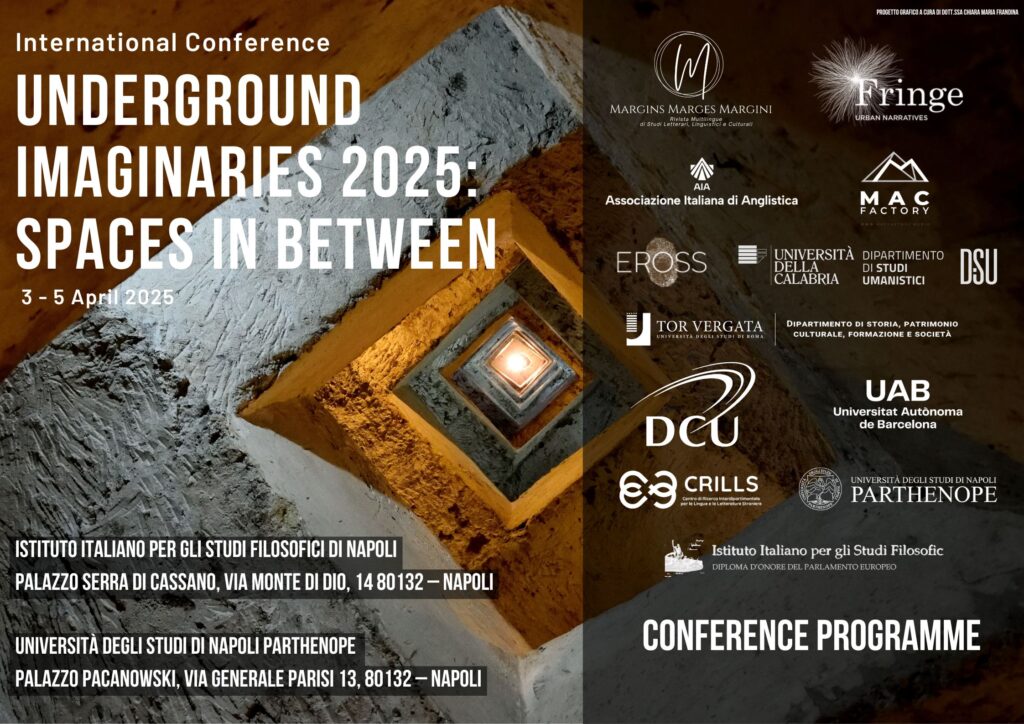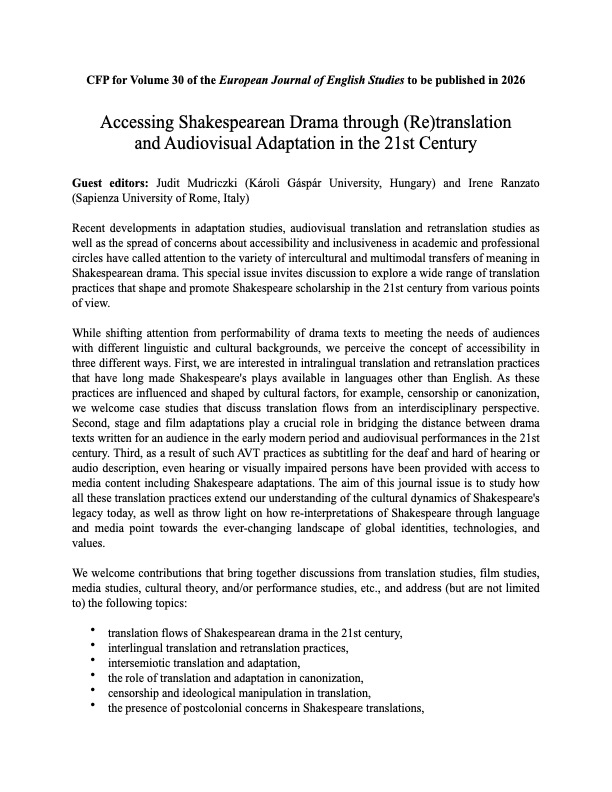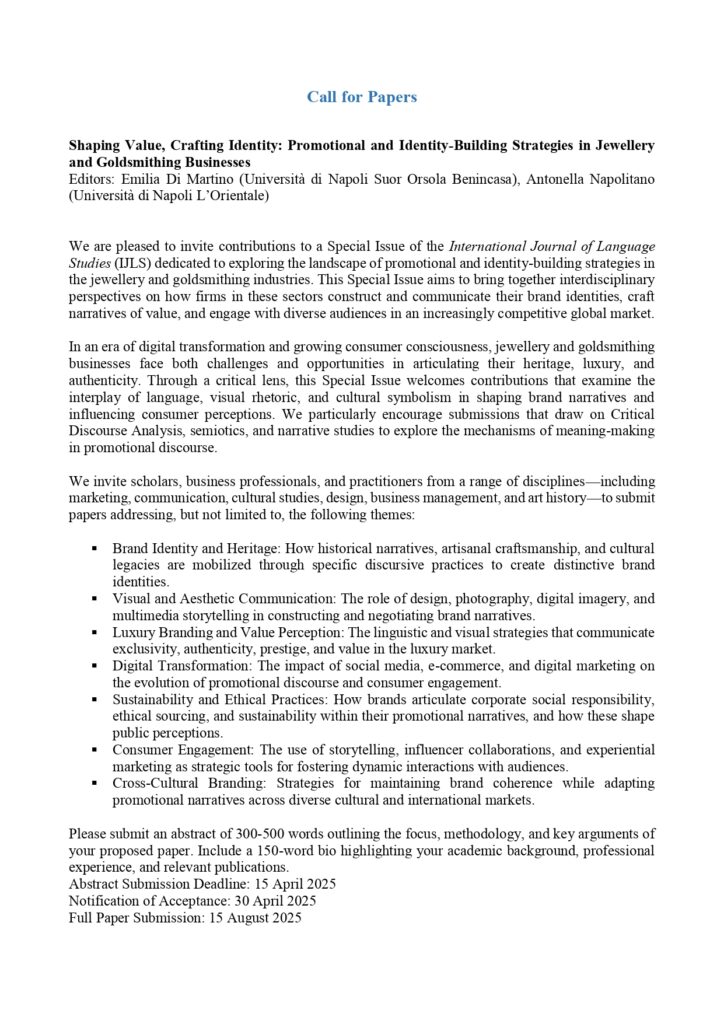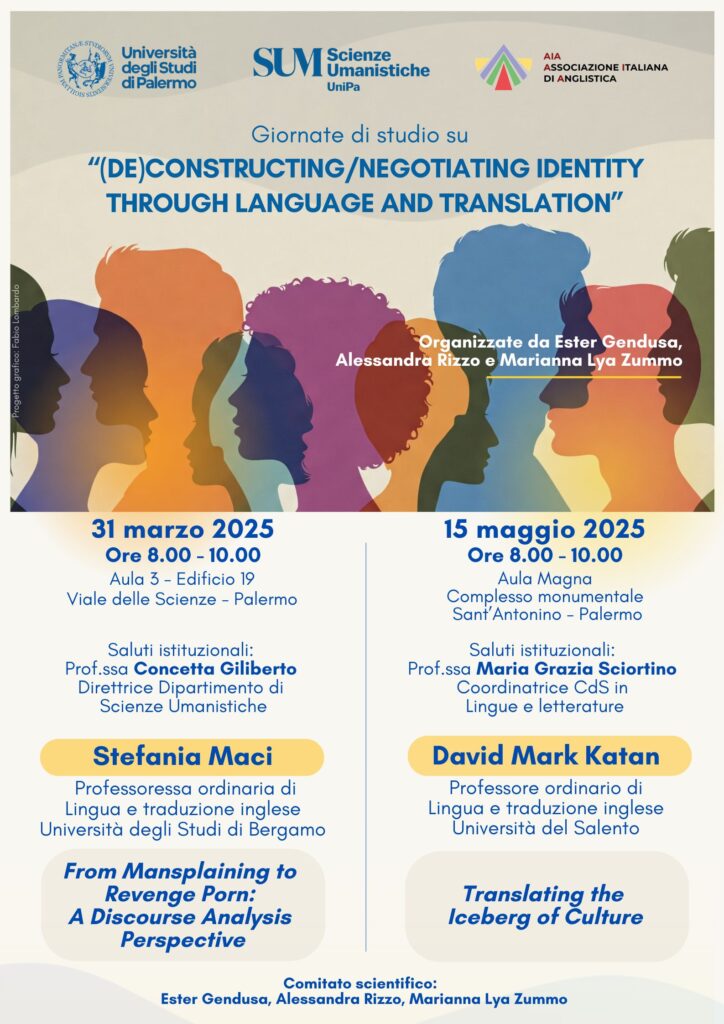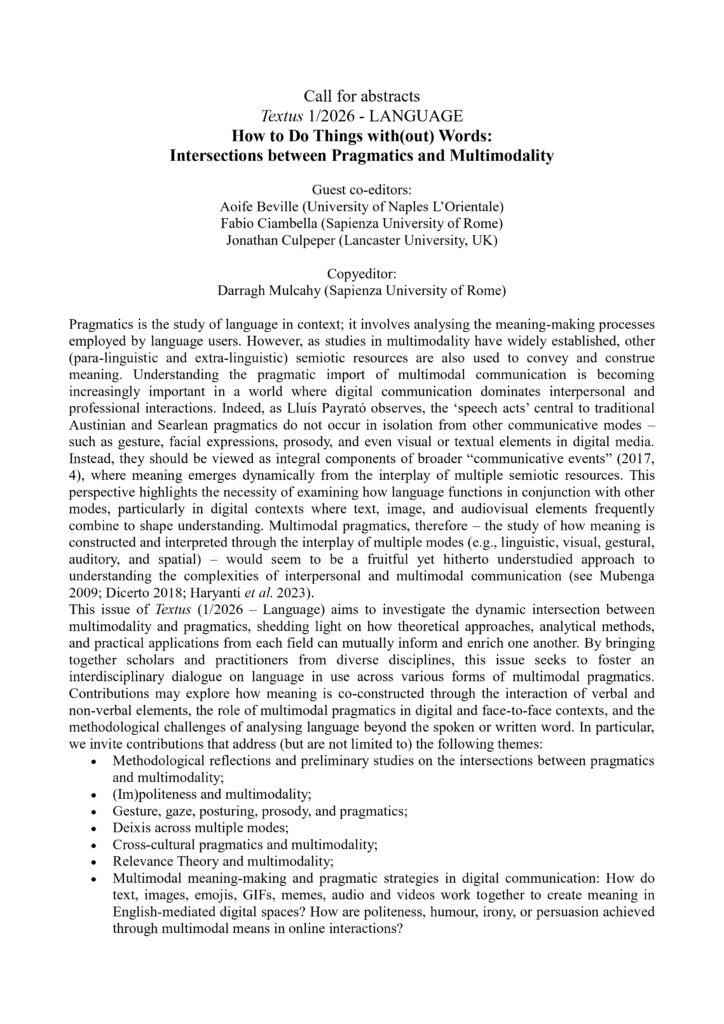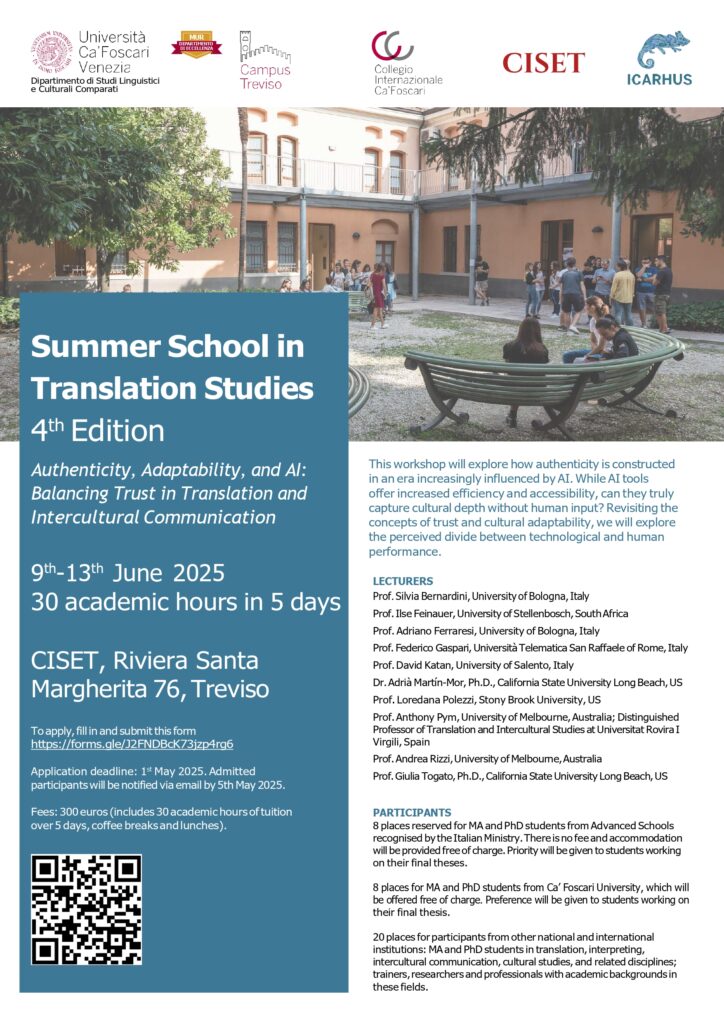Marzo 2025
Call for Papers – XXVIII International Conference of O&L
Potenza 24-26 September 2025The XXVIII International Conference of O&L will take place at the University of Basilicata. The conference will be held in the Aula Magna of the Francioso Campus and in the Hall of the National Archaeological Museum of Basilicata Dinu Adamesteanu, Potenza. Additionally, on September 27, a visit will be organized to the Sassi of Matera, which were listed as a UNESCO World Heritage Site in 1993. The detailed program of the visit and the registration procedures will be provided to interested participants. The Conference will focus on the following topics:The names of ‘villains’ (antagonists and negative characters).The relevance of the names of literary ‘villains’ and/or ‘antagonists’ is already evident when we consider a peculiar linguistic phenomenon: many of them have become so famous that they have turned into antonomasies, or even lexicalized into deonyms. Among those attested in the lexical heritage of Italian and its dialects, one could think, for example, of ‘Ganelon / Gano di Maganza,’ which has become synonymous with ‘traitor’ (alongside ‘giuda’), also appearing with the epithet ‘(treacherous) Maganzese’. Beyond this, other purely literary cases can be listed within the same domain, which have already been studied by critics, such as the names of the devils Malebranche in Dante’s Divine Comedy and those of the Shakespearean theatrical characters Macbeth, Shylock, Iago, or the Molière character Tartuffe, may be counted in the same sphere. The name in autobiographical writingsIn autobiography, understood as a literary form, there is an onomastic identity between the author, narrator, and protagonist, which refers to the same entity. The enunciation of the name of the authornarrator-protagonist, therefore, constitutes a key element for reading, capable of guiding the reader’s interpretative cooperation and the process of meaning-making within the work. However, the enunciation of the nominal identity of the one who takes the floor rarely appears within the text, while it is often displayed in the paratext. The narrator who designates himself with a first-person pronoun, therefore, does not have a name, and yet, as Roland Barthes emphasizes, that pronoun, in the narrative, becomes an anthroponym, unless the narrator leaves some onomastic trace within the text. Equally significant are the procedures that affect the names of other characters involved in autobiographical writings, which may, for example, be subject to various kinds of omissions, because they are hidden by anonymity or disguised through substitute names. The same ambivalent attitude may also involve the names of the places where the action is set. Therefore, this section could include all investigations aimed at detecting and revealing the often unsuspected autobiographical resonances hidden behind the onomastics of a text. Anthropological foundations of the name: taboo, apotropaic or magical namesIt is well known that in Le Conte du Graal by Chrétien de Troyes, the reader (and the character who bears the name) comes to know the protagonist’s name only at a very advanced stage of the poem: the revelation assumes an initiatory value, reaching the peak of a difficult process of self-knowledge. The Kretienian ‘taboo of the name’ is certainly not the only example where a literary name seems to regain the magical and apotropaic significance, with complex anthropological meanings, traces of which were widespread and profound in primitive onomastics, and which also characterized the prohibition of pronouncing the divine Tetragrammaton in Jewish tradition. However, in this section, which could also be titled, playing on Freud’s words, Nomen and tabù, one could certainly include other well-known cases seen from different perspectives, such as that of the Erinyes, often referred to by the apotropaic name Eumenides (as in Aeschylus’s tragedy or in the title of the famous novel by Jonathan Littell, Les Bienveillantes, which mirrors the same mythological model of the persecution of Orestes by the Erinyes); or famous literary examples, such as the case of the figure of the Innominato in Manzoni’s novel, struck by a sort of interdiction that evokes the previously mentioned prohibition of pronouncing the divine name. Cases of autonymy: when a character assigns themselves a name, a nickname, or a pseudonymAmong the cases in which a literary character is compelled, for various reasons, to re-name themselves, the first examples that come to mind are certainly classic ones, such as Alonso Quijano / Don Quixote, Jekyll / Hyde, or, in twentieth-century Italian literature, Mattia Pascal / Adriano Meis. Beyond this specific corpus, however, other forms of autonymy can be found, even if seemingly less striking, such as those of the Decameron characters, who assume different onomastic forms from their official names during various disguises: from Tebaldo degli Elisei / Filippo di San Lodeccio to Lodovico / Anichino, or, with a change of gender, Madonna Zinevra / Sicuran da Finale. To mention a twentieth-century example, one can think of the programmatic battle names that partisans give themselves in post-World War II stories. But other types can also be suggested. One involves the author themselves when they, to some extent, take on a substitute name, either to hide or, conversely, to showcase a particular authorial stance. One thinks of the kaleidoscopic array of heteronyms by Pessoa, but also more unsuspected cases, such as that of Luzi, who in some collections hints at himself under real names and profiles like Simone Martini. Also, in the realm of authorial posture, one can cite the self-deprecating, diminutive autonyms, with a programmatically self-ironic and reductive intent, such as ‘guidogozzano’. Submerged Lucanità: Onomastic Explorations from Rocco Scotellaro to Gaetano CappelliThe occasion of the conference in Potenza offers numerous onomastic insights not only for the general ‘anniversary section’ but also for the more specific literary production of Lucanian authors. This year, in particular, marks the fiftieth anniversary of the death of Carlo Levi, whose Christ Stopped at Eboli (it is needless to emphasize its significance in the history of Basilicata) reveals a complex relationship between reality and invention, particularly within the onomastic fiction. Additionally, the onomastic choices of Lucanian poets and writers, which draw from the reality of the so-called peasant civilization, are still underexplored but certainly worth investigating. These include Rocco
Call for Papers – XXVIII International Conference of O&L Read More »
CALL FOR PAPERS for Volume 30 of the European Journal of English Studies to be published in 2026
Accessing Shakespearean Drama through (Re)translation and Audiovisual Adaptation in the 21st Century Guest editors: Judit Mudriczki (Károli Gáspár University, Hungary) and Irene Ranzato (Sapienza University of Rome, Italy)Recent developments in adaptation studies, audiovisual translation and retranslation studies as well as the spread of concerns about accessibility and inclusiveness in academic and professional circles have called attention to the variety of intercultural and multimodal transfers of meaning in Shakespearean drama. This special issue invites discussion to explore a wide range of translation practices that shape and promote Shakespeare scholarship in the 21st century from various points of view. While shifting attention from performability of drama texts to meeting the needs of audiences with different linguistic and cultural backgrounds, we perceive the concept of accessibility inthree different ways. First, we are interested in intralingual translation and retranslation practices that have long made Shakespeare’s plays available in languages other than English. As these practices are influenced and shaped by cultural factors, for example, censorship or canonization, we welcome case studies that discuss translation flows from an interdisciplinary perspective. Second, stage and film adaptations play a crucial role in bridging the distance between drama texts written for an audience in the early modern period and audiovisual performances in the 21st century. Third, as a result of such AVT practices as subtitling for the deaf and hard of hearing or audio description, even hearing or visually impaired persons have been provided with access to media content including Shakespeare adaptations. The aim of this journal issue is to study how all these translation practices extend our understanding of the cultural dynamics of Shakespeare’s legacy today, as well as throw light on how re-interpretations of Shakespeare through language and media point towards the ever-changing landscape of global identities, technologies, and values. We welcome contributions that bring together discussions from translation studies, film studies, media studies, cultural theory, and/or performance studies, etc., and address (but are not limited to) the following topics: • translation flows of Shakespearean drama in the 21st century,• interlingual translation and retranslation practices,• intersemiotic translation and adaptation,• the role of translation and adaptation in canonization,• censorship and ideological manipulation in translation,• the presence of postcolonial concerns in Shakespeare translations,• inclusiveness and media accessibility of Shakespeare adaptations,• audiovisual translation practices of screen adaptations,• audio description and subtitling of Shakespeare on screen,• surtitling Shakespeare performances. Detailed proposals (up to 1,000 words) for full essays (approx. 7,500 words), as well as a short biography (max.100 words) should be sent to both editors by 20 April 2025: Judit Mudriczki (mudriczki.judit@kre.hu) and Irene Ranzato (irene.ranzato@uniroma1.it) EJES operates in a two-stage review process.1. Contributors are invited to submit proposals for essays on the topic in question by 20 April 2025.2. Following review of the proposals by the editorial board panel, informed by external specialists as appropriate, the guest editors will invite the authors of short-listed proposals to submit full-length essays for review with a summer 2025 deadline.3. The full-length essays undergo a second round of review, and a final selection for publication is made. Selected essays are revised and then resubmitted to the guest editors in late 2025 for publication in 2026. EJES employs Chicago Style (T&F Chicago AD) and British English conventions for spelling. For more information about EJES, see: http://www.essenglish.org/ejes.html and https://[www.tandfonline.com/toc/neje20/current]www.tandfonline.com/toc/neje20/current
International Journal of Language Studies – Call for Papers: Shaping Value, Crafting Identity: Promotional and Identity-Building Strategies in Jewellery and Goldsmithing Businesses
Editors: Emilia Di Martino (Università di Napoli Suor Orsola Benincasa), Antonella Napolitano(Università di Napoli L’Orientale)We are pleased to invite contributions to a Special Issue of the International Journal of LanguageStudies (IJLS) dedicated to exploring the landscape of promotional and identity-building strategies inthe jewellery and goldsmithing industries. This Special Issue aims to bring together interdisciplinaryperspectives on how firms in these sectors construct and communicate their brand identities, craftnarratives of value, and engage with diverse audiences in an increasingly competitive global market.In an era of digital transformation and growing consumer consciousness, jewellery and goldsmithingbusinesses face both challenges and opportunities in articulating their heritage, luxury, andauthenticity. Through a critical lens, this Special Issue welcomes contributions that examine theinterplay of language, visual rhetoric, and cultural symbolism in shaping brand narratives andinfluencing consumer perceptions. We particularly encourage submissions that draw on CriticalDiscourse Analysis, semiotics, and narrative studies to explore the mechanisms of meaning-makingin promotional discourse.We invite scholars, business professionals, and practitioners from a range of disciplines—includingmarketing, communication, cultural studies, design, business management, and art history—to submitpapers addressing, but not limited to, the following themes:▪ Brand Identity and Heritage: How historical narratives, artisanal craftsmanship, and culturallegacies are mobilized through specific discursive practices to create distinctive brandidentities.▪ Visual and Aesthetic Communication: The role of design, photography, digital imagery, andmultimedia storytelling in constructing and negotiating brand narratives.▪ Luxury Branding and Value Perception: The linguistic and visual strategies that communicateexclusivity, authenticity, prestige, and value in the luxury market.▪ Digital Transformation: The impact of social media, e-commerce, and digital marketing onthe evolution of promotional discourse and consumer engagement.▪ Sustainability and Ethical Practices: How brands articulate corporate social responsibility,ethical sourcing, and sustainability within their promotional narratives, and how these shapepublic perceptions.▪ Consumer Engagement: The use of storytelling, influencer collaborations, and experientialmarketing as strategic tools for fostering dynamic interactions with audiences.▪ Cross-Cultural Branding: Strategies for maintaining brand coherence while adaptingpromotional narratives across diverse cultural and international markets.Please submit an abstract of 300-500 words outlining the focus, methodology, and key arguments ofyour proposed paper. Include a 150-word bio highlighting your academic background, professionalexperience, and relevant publications.Abstract Submission Deadline: 15 April 2025Notification of Acceptance: 30 April 2025Full Paper Submission: 15 August 2025Please send your abstracts and biographical notes to emilia.dimartino@unisob.na.it andanapolitano@unior.it with the subject line “CFP Submission: Shaping Value, Crafting Identity.”ReferencesBhatia, V. (2008). Generic patterns in promotional discourse. In Persuasion across genres: Alinguistic approach (pp. 213-225). John Benjamins Publishing Company.Cappellieri, A. (2020). Jewellery between product and experience: Luxury in the Twenty-Firstcentury. In L. Tenuta, S. Testa, A. Cappellieri, Sustainable Luxury and Craftsmanship.Springer, 1-30.Cappellieri, A. (2021). Diva! Il Glamour Italiano nel Gioiello Moda. SilvanaEditoriale.Caves, R. E. (2000). Creative industries: Contracts between art and commerce. Harvard University.Holt, D. B. (2002). Why do brands cause trouble? A dialectical theory of consumer culture andbranding. Journal of consumer research, 29(1), 70-90.Dlaske, K. (2015). Discourse matters: Localness as a source of authenticity in craft businesses inperipheral minority language sites. Critical Approaches to Discourse Analysis acrossDisciplines, 7(2).Kapferer, J. N. (2014). The artification of luxury: From artisans to artists. Business horizons, 57(3),371-380.Kapferer, J. N. (2012). The luxury strategy: Break the rules of marketing to build luxurybrands. Hogan Page.Ko, E., Costello, J. P., & Taylor, C. R. (2019). What is a luxury brand? A new definition and reviewof the literature. Journal of Business Research, 99, 405-413.Koller, V. (2009). Brand images: Multimodal metaphor in corporate branding messages. Multimodalmetaphor, 11, 45-72.Lazazzera, M. (2024). Six trends shaping the jewellery industry now. Vogue Business. November 4,2024.Lury, C. (2004). Brands: The logos of the global economy. Routledge.Okonkwo, U. (2010). Luxury Online: Styles, Systems, Strategies. Palgrave Macmillan.Truong, Y., McColl, R., & Kitchen, P. J. (2009). New luxury brand positioning and the emergenceof masstige brands. Journal of Brand Management, 16(5), 375-382.
Giornate di studio su “(De)Constructing/Negotiating Identity through Language and Translation”
Organizzate da Ester Gendusa, Alessandra Rizzo e Marianna Lya Zummo 31 marzo 2025 Ore 8.00 – 10.00 Aula 3 – Edificio 19 Viale delle Scienze – Palermo Saluti istituzionali: Prof.ssa Concetta Giliberto Direttrice Dipartimento di Scienze Umanistiche Stefania Maci Professoressa ordinaria di Lingua e traduzione inglese – Università degli Studi di Bergamo From Mansplaining to Revenge Porn: A Discourse Analysis Perspective 15 maggio 2025 Ore 8.00 – 10.00 Aula Magna Complesso monumentale Sant’Antonino – Palermo Saluti istituzionali: Prof.ssa Maria Grazia Sciortino Coordinatrice CdS in Lingue e letterature David Mark Katan Professore ordinario di Lingua e traduzione inglese Università del Salento Translating the Iceberg of Culture Comitato scientifico: Ester Gendusa, Alessandra Rizzo, Marianna Lya Zummo
International MA Programme in Accessibility to Media, Arts, and Culture (AMAC), University of Macerata – Applications Open
Now in its fourth edition, AMAC offers internationally oriented training for professionals in accessibility across media, arts, and culture. This year, the programme introduces a brand new module: Training Accessibility Managers, equipping students with the expertise to develop and implement accessibility strategies. AMAC also prepares students for careers as consultants for media and cultural events, inclusive design coordinators, and specialists in audio description, interlingual subtitling, easy-to-read language, sign language, and more.The programme includes online classes, workshops, and dedicated lectures, offering both theoretical and practical training. Students also have the opportunity to gain hands-on experience through work placements and project work. Courses are delivered in English, with practical activities in both English and Italian. 📄 Learn more: Brochure https://masteramac.unimc.it/wp-content/uploads/2025/03/EN_brochure-AMAC.pdf 🌍 Apply now: Website https://masteramac.unimc.it/
Call for abstracts Textus 3/2026 – CROSS-DISCIPLINARY ISSUE
Voices Across Borders: Reframing the Barriers of Vulnerability in Language, Culture, and Literature Guest co-editors: Gaetano Falco (Università degli Studi di Bari “Aldo Moro”) Elena Spandri (Università degli Studi di Siena) Jun Pan (Hong Kong Baptist University) Copyeditor: Eileen Mulligan (University of Bari) In an increasingly hostile transnational political climate and environment, where current sweeping policy-making bodies demonize notions and practices of diversity, equity, and inclusion, fostering division within and between societies, nation-states, and cultures, the need to encourage inclusive dialogue in academic research has never been more pressing. By reframing the barriers of vulnerability in all its forms—whether linguistic, cultural, social, and digital, or in their literary representation— this issue of Textus intends to construct a comprehensive and vibrant space for scholarly investigation and social change, encouraging interdisciplinary conversation. Vulnerability is a concept that usually implies the related ideas of fragility, inequity, and risk, but is also associated with resilience, empowerment and resistance (Butler 2014). It “is a concept with fleeting contours as much as it is an idea with assured academic success” (Ferrarese 2016:149). As such, it is characterized by indeterminacy and variability, which accounts for the current, “increasingly multidisciplinary interest in the topic.” (Nungesser and Schirgi 2024: 252). Over the last decades, the notion has gained the attention of various research areas, both embracing and articulating its conceptual boundaries, as the idea itself has been subject to reconceptualization in the field of international human rights law (Morawa 2003). The call for Voices Across Borders offers itself to multiple inflections, showcasing the need for change and empowerment as a key quality that underlies recent developments in the fields of – amongst others – (critical) discourse analysis, literary studies, cultural studies, (critical) disability studies, gender studies, environmental studies, migration, border discourse and cultural mediation, and museum studies. Among the possible angles, one may consider for instance exploring the pliability of the novel form to contemporary ‘humanitarian imaginary’ in the current context marked by a pervasive condition of conflict, the massive experience of vulnerability and mediatic exposure to violence (Ganguly 2016). Another option may be to consider the dual role of language as both a barrier and a bridge across various fields, including translation and communication (Davies 2012); or, as a resource for inclusion and a cause of exclusion of vulnerable groups, ranging from migrants to refugees and asylum seekers (Schrover and Schinkel, 2013), to women and LGBTQI+ people (Jones 2023). The papers selected will ideally address the core topic from either theoretical or applied and text-focussed perspectives, in literature, linguistics, and cultural studies, including discussion of best practices in teaching and other professional experiences. References Antinucci, Raffaella, and Adrian Grafe (eds.). Vulnerability and Resilience in English Literature of the Long Nineteenth Century (McFarland, 2024). Bonacchi, Silvia, ed. Vulnerability: Real, Imagined, and Displayed Fragility in Language and Society. Göttingen: Vandenhoeck & Ruprecht unipress, 2024. Butler, Judith. “Introduction: On Linguistic Vulnerability.” In Excitable Speech: A Politics of the Performative. New York: Routledge, 1997: 1-42. Butler, Judith. “Rethinking Vulnerability and Resistance.” In Judith Butler, Zeynep Gambetti, and Leticia Sabsay (ed. by), Vulnerability in Resistance, Duke UP, 2016, pp.12-27. Butler, Judith, Precarious Lives: The Powers of Mourning and Violence (Verso, 2006). Cunningham, Clare, and Christopher J. Hall, eds. Vulnerabilities, Challenges and Risks in Applied Linguistics. Bristol: Multilingual Matters, 2021. Davies, Eirlys E. “Translation and Intercultural Communication: Bridges and Barriers.” In C. B. Paulston, S. F. Kiesling, & E. S. Rangel (Eds.), The Handbook of Intercultural Discourse and Communication. Wiley-Blackwell 2012, pp. 367–387. De Vogli R., Lusiardi M. (2024) “The Ecological Crisis and Human Rights: Why We Are All Vulnerable ” Peace Human Rights Governance, 8(1), 135-152. Ferrarese, Estelle. “Vulnerability: A Concept with Which to Undo the World As It Is?”. Critical Horizons, 17, 2 (2016): 149-159. https://doi.org/10.1080/14409917.2016.1153885 Fernández-Santiago, Miriam, and Cristina M. Gámez- Fernández (eds.). Representing Vulnerabilities in Contemporary Literature (Routledge, 2022). Ganassin, Sara, Alexandra Georgiou, Judith Reynolds, and Mohammed Ateek. 2024. “Vulnerability and Multilingualism in Intercultural Research with Migrants: Developing an Inclusive Research Practice.” Language and Intercultural Communication 24 (5): 385–93. doi:10.1080/14708477.2024.2411083. Ganguly, Debjani, This Thing Called the World. The Contemporary Novel as Global Form (Duke UP, 2016). Ganteau, Jean Michel. The Ethics and Aesthetics of Vulnerability in Contemporary British Fiction (Routledge, 2015). Giladi, Paul, and Petherbridge, Danielle. “The Vulnerable Dynamics of Discourse”. Royal Institute of Philosophy Supplement. 2021: 195-225. doi:10.1017/S1358246121000151 Heikkilä, Mikaela, and Maija Mustaniemi-Laakso. “Introduction: Approaches to Vulnerability in Times of Crisis.” Human Rights Review (2023) 24:151–170. Jones, Lucy, “Language, gender and sexuality in 2022”, Gender and Language, 17, 2 (2023): 1-18. Lewis, Hannah, Precarious Lives: Forced Labour, Exploitation and Asylum (Policy Press, 2014). Morawa, Alexander E., “Vulnerability as a Concept of International Human Rights Law”, Journal of International Relations and Development 6, 2 (June 2003): 139-155. Nixon, Rob, Slow Violence and the Environmentalism of the Poor (Harvard UP, 2011). Nungesser, Frithjof, and Antonia Schirgi. “Debating the Vulnerability Zeitgeist: Introduction to an Interdisciplinary Trialogue.” Human Studies, 47, 2 (2024): 251–260. Scarry, Elain, The Body in Pain: The Making and Unmaking of the World (OUP, 1985). Schrover, Marlou, and Willem Schinkel. “Introduction: the language of inclusion and exclusion in the context of immigration and integration”, Ethnic and Racial Studies 36, 7 (2013): 1123-1141. Slaughter, Joseph R., Human Rights, Inc. The World Novel, Narrative Form, and International Law (Fordham UP, 2007). Wu, Duncan, and Carolyne Forché (eds.) Poetry of Witness: The Tradition in English 1500-2001 (Norton, 2014). Submission of abstracts Please send abstracts to: gaetano.falco@uniba.it, Timeline Deadline for abstracts submission (400 words plus references): 15 December 2025. Please put as subject line “Textus Cross-disciplinary Issue 6/2025 – abstract submission” Notification to authors: 15 January 2026 Deadline for submission of first draft of article (maximum 7500 words including references): 31 May 2026 Request for revisions following peer review: 15 July 2026 Deadline for final version of article: 1 September 2026
Call for abstracts Textus 3/2026 – CROSS-DISCIPLINARY ISSUE Read More »
Call for abstracts Textus 2/2026 – LITERATURE
Writing the End, Imagining the Future: Ecoapocalypses and Ecotopias in Anglophone Literature Guest co-editors: Gioia Angeletti (Università di Parma) Roberta Grandi (Università della Valle d’Aosta) Nicoletta Vallorani (Università degli Studi di Milano) Lykke Harmony Alara Guanio-Uluru (Western Norway University of Applied Sciences) Copyeditor: Elizabeth Ritsema (Royal Holloway – University of London) In The Last Man (1826), Shelley thus envisioned the annihilation of the human race: an endemic disease being turned into a pandemic plague by a combination of war-related increase in human contacts and an unprecedented rise in air temperature. Nearly a century and a half later, Callenbach’s Ecotopia (1975) imagined a sustainable society featuring mandatory waste recycling and electric engines, widespread bike-sharing, and advanced technological devices called “picturephones.” Science fiction has long exhibited an uncanny ability to anticipate the worst – and, more rarely, the best – of possible futures. Yet today, as climate change, global warming, the sixth mass extinction, phosphogeddon, and other eco-catastrophes have ceased to be speculative concerns and instead define the lived reality of many communities, the once-cathartic potential of apocalyptic narratives may be diminishing. As noticed by Amitav Ghosh, “There is, […], an important difference between the weather events that we are now experiencing and those that occur in surrealist and magical realist novels: improbable though they might be, these events are neither surreal nor magical. To the contrary, these highly improbable occurrences are overwhelmingly, urgently, astoundingly real.” (2017, 27) Over the last decades, eco-apocalyptic and dystopian works have functioned as a means of reflecting on contemporary environmental crises, serving as cautionary tales designed to warn and engage readers with urgent global concerns (Basu, Broad, and Hintz 2013; Bradford et al. 2008; Curry 2013). However, recent interdisciplinary research spanning psychology, anthropology, affect studies, environmental activism, participatory culture, and speculative fiction (Callahan et al. 2019; de Moor et al. 2020; Leyda 2023; Lockyer and Veteto 2015; McKinley 2008; Nairn 2019; Oziewicz, Attebery, and Dědinová 2022; Weik von Mossner 2017) suggests that an overreliance on apocalyptic frameworks may be counterproductive. Scholars argue that narratives centred on climate catastrophe risk engendering paralysis rather than action, as they can reinforce the perception of an inevitable and insurmountable collapse, discouraging proactive engagement with environmental challenges (Arnold 2018; Hull 2019). In response, alternative genres such as ecotopias and solarpunk offer visions of the future that inspire optimism rather than despair. These narratives imagine worlds that are not only sustainable but deeply appealing, fostering a desire for systemic transformation and encouraging active participation in building a more just and environmentally integrated society (Ulibarri 2022; Weik von Mossner 2017). This issue of Textus invites contributions that examine eco-apocalyptic visions, climate fiction, and environmental dystopias, as well as alternative imaginaries such as ecotopias, solarpunk, fantasy, afrofuturist and feminist utopias. We welcome ecocritical analyses of both classic and contemporary works of adult and children’s literature, along with other critical approaches informed by ecofeminism, intersectionality, blue and green humanities, energy humanities, posthumanism, new materialism, and affect studies. References Arnold, Elizabeth. 2018. ‘Doom and Gloom: The Role of the Media in Public Disengagement on Climate Change’. Shoresteincenter.Org (blog). 28 May 2018. Basu, Balaka, Katherine R. Broad, and Carrie Hintz, eds. 2013. Contemporary Dystopian Fiction for Young Adults.Brave New Teenagers. London, New York: Routledge. Bradford, Clare, Kerry Mallan, John Stephens, and Robyn McCallum. 2008. New World Orders in Contemporary Children’s Literature. London: Palgrave Macmillan UK. https://doi.org/10.1057/9780230582583. Buell, Lawrence. 2005. The Future of Environmental Criticism: Environmental Crisis and Literary Imagination. Blackwell Manifestos. Malden, MA: Blackwell Pub. Callahan, Megan M., Alejandra Echeverri, David Ng, Jiaying Zhao, and Terre Satterfield. 2019. ‘Using the Phylo Card Game to Advance Biodiversity Conservation in an Era of Pokémon’. Palgrave Communications 5 (1): 1–10. https://doi.org/10.1057/s41599-019-0287-9. Clark, Timothy. 2015. Ecocriticism on the Edge: The Anthropocene as a Threshold Concept. London, New York: Bloomsbury Academic, an imprint of Bloomsbury Publishing Plc. Curry, Alice. 2013. Environmental Crisis in Young Adult Fiction. London: Palgrave Macmillan UK. https://doi.org/10.1057/9781137270115. Dawson, Ashley. 2017. Extreme Cities: The Peril and Promise of Urban Life in the Age of Climate Change. London , New York: Verso. Garrard, Greg. 2004. Ecocriticism. London: Routledge. https://doi.org/10.4324/9780203644843. Ghosh, Amitav. 2017. The Great Derangement: Climate Change and the Unthinkable. The Randy L. and Melvin R. Berlin Family Lectures. Chicago: The University of Chicago press. Glotfelty, Cheryll, and Harold Fromm, eds. 2009. The Ecocriticism Reader: Landmarks in Literary Ecology. Nachdr. Athens, Ga.: Univ. of Georgia Press. Hull, Alyssa. 2019. ‘Hopepunk and Solarpunk: On Climate Narratives That Go Beyond the Apocalypse’. Literary Hub (blog). 22 November 2019. https://lithub.com/hopepunk-and-solarpunk-on-climate-narratives-that-go-beyond-the-apocalypse/. Iovino, Serenella, and Serpil Oppermann, eds. 2014. Material Ecocriticism. Bloomington: Indiana University Press. Leyda, Julia. 2023. Anthroposcreens: Mediating the Climate Unconscious. 1st ed. Cambridge University Press. https://doi.org/10.1017/9781009317702. Lockyer, Joshua, and James R. Veteto, eds. 2015. Environmental Anthropology Engaging Ecotopia: Bioregionalism, Permaculture, and Ecovillages. First paperback edition. Studies in Environmental Anthropology and Ethnobiology, volume 17. New York, Oxford: Berghahn. McKinley, Andrew. 2008. ‘Hope in a Hopeless Age: Environmentalism’s Crisis’. The Environmentalist 28 (3): 319–26. https://doi.org/10.1007/s10669-008-9169-1. Moor, Joost de, Katrin Uba, Mattias Wahlström, Magnus Wennerhag, Michiel De Vydt, Piotr Kocyba, Michael Neuber, et al. 2020. Protest for a Future II: Composition, Mobilization and Motives of the Participants in Fridays For Future Climate Protests on 20-27 September, 2019, in 19 Cities around the World. Nairn, Karen. 2019. ‘Learning from Young People Engaged in Climate Activism: The Potential of Collectivizing Despair and Hope’. YOUNG 27 (5): 435–50. https://doi.org/10.1177/1103308818817603. Oziewicz, Marek, Brian Attebery, and Tereza Dědinová, eds. 2022. Fantasy and Myth in the Anthropocene: Imagining Futures and Dreaming Hope in Literature and Media. London, New York: Bloomsbury Academic. Plumwood, Val. 2007. Environmental Culture: The Ecological Crisis of Reason. Environmental Philosophies Series. London: Routledge. Ulibarri, Sarena. 2022. ‘Do You Believe in Climate Solutions? You Just Might Be a Solarpunk.’ Fix. 4 April 2022. https://grist.org/fix/climate-fiction/do-you-believe-in-climate-solutions-you-just-might-be-a-solarpunk/. Weik von Mossner, Alexa. 2017. Affective Ecologies: Empathy, Emotion, and Environmental Narrative. Cognitive Approaches to Culture. Columbus: The Ohio State University Press. Submission of abstracts and timeline Please send abstracts to: gioia.angeletti@unipr.it, r.grandi@univda.it, nicoletta.vallorani@unimi.it Timeline Deadline for abstracts submission (400 words plus references): 15 September
Call for abstracts Textus 2/2026 – LITERATURE Read More »
Call for abstracts Textus 1/2026 – LANGUAGE
How to Do Things with(out) Words: Intersections between Pragmatics and Multimodality Guest co-editors: Aoife Beville (University of Naples L’Orientale) Fabio Ciambella (Sapienza University of Rome) Jonathan Culpeper (Lancaster University, UK) Copyeditor: Darragh Mulcahy (Sapienza University of Rome) Pragmatics is the study of language in context; it involves analysing the meaning-making processes employed by language users. However, as studies in multimodality have widely established, other (para-linguistic and extra-linguistic) semiotic resources are also used to convey and construe meaning. Understanding the pragmatic import of multimodal communication is becoming increasingly important in a world where digital communication dominates interpersonal and professional interactions. Indeed, as Lluís Payrató observes, the ‘speech acts’ central to traditional Austinian and Searlean pragmatics do not occur in isolation from other communicative modes – such as gesture, facial expressions, prosody, and even visual or textual elements in digital media. Instead, they should be viewed as integral components of broader “communicative events” (2017, 4), where meaning emerges dynamically from the interplay of multiple semiotic resources. This perspective highlights the necessity of examining how language functions in conjunction with other modes, particularly in digital contexts where text, image, and audiovisual elements frequently combine to shape understanding. Multimodal pragmatics, therefore – the study of how meaning is constructed and interpreted through the interplay of multiple modes (e.g., linguistic, visual, gestural, auditory, and spatial) – would seem to be a fruitful yet hitherto understudied approach to understanding the complexities of interpersonal and multimodal communication (see Mubenga 2009; Dicerto 2018; Haryanti et al. 2023). This issue of Textus (1/2026 – Language) aims to investigate the dynamic intersection between multimodality and pragmatics, shedding light on how theoretical approaches, analytical methods, and practical applications from each field can mutually inform and enrich one another. By bringing together scholars and practitioners from diverse disciplines, this issue seeks to foster an interdisciplinary dialogue on language in use across various forms of multimodal pragmatics. Contributions may explore how meaning is co-constructed through the interaction of verbal and non-verbal elements, the role of multimodal pragmatics in digital and face-to-face contexts, and the methodological challenges of analysing language beyond the spoken or written word. In particular, we invite contributions that address (but are not limited to) the following themes: · Methodological reflections and preliminary studies on the intersections between pragmatics and multimodality; · (Im)politeness and multimodality; · Gesture, gaze, posturing, prosody, and pragmatics; · Deixis across multiple modes; · Cross-cultural pragmatics and multimodality; · Relevance Theory and multimodality; · Multimodal meaning-making and pragmatic strategies in digital communication: How do text, images, emojis, GIFs, memes, audio and videos work together to create meaning in English-mediated digital spaces? How are politeness, humour, irony, or persuasion achieved through multimodal means in online interactions? · Multimodal pragmatics in emerging technologies: What roles do Artificial Intelligence (AI), augmented reality, and virtual reality play in evolving multimodal communication? · Pedagogy: what are the current challenges and opportunities of teaching multimodal literacy and pragmatic competence in English language courses? · Stylistic and aesthetic functions: how do literary, artistic, theatrical and telecinematic texts employ pragmatic strategies across multiple modes? What aesthetic effects are achieved, and how do these contribute to the interpretation of such texts? · Ethical and social dimensions: How do issues of accessibility, inclusivity, and power manifest in multimodal pragmatics online? References BELTRÁN-PLANQUES, VICENT and QUEROL-JULIÁN, MERCEDES, 2018, “English Language Learners’ Spoken Interaction: What a Multimodal Perspective Reveals about Pragmatic Competence”, System 77, pp. 80-90. CULPEPER, JONATHAN, MICHAEL HAUGH, and DÁNIEL Z. KÁDÁR, 2017, (Eds.) The Palgrave Handbook of Linguistic (Im)Politeness. Palgrave Macmillan, London. DICERTO, SARA, 2018, Multimodal Pragmatics and Translation: A New Model for Source Text Analysis, Palgrave Macmillan, London. HARYANTI, PUTRI, SADDHONO, KUNDHARU and ANINDYARINI, ATIKAH, 2023, “Multimodal as a New Perspective in Pragmatics in the Digital Era: Literature Review”, ICHSS 3, pp. 494-501. INDARTI, DWI, 2024, “Multimodalities and Conversational Implicature in Cross-Cultural Pragmatic Context: A Systematic Review”, International Journal of Social Science and Human Research 7 (12), pp. 9271-80. KRESS, GUNTHER R. and VAN LEEUWEN. THEO, 2020, Reading Images: The Grammar of Visual Design. Third Edition. Routledge, London. MUBENGA, KAJINGULU SOMWE, 2009, “Towards a Multimodal Pragmatic Analysis of Film Discourse in Audiovisual Translation”, META 54 (3), pp. 466-84. NØRGAARD, NINA. 2023 ‘Multimodality and Stylistics’. In M. Burke (ed) The Routledge Handbook of Stylistics, Second Edition. Routledge, London. pp. 506–20. O’HALLORAN, KAY L., TAN, SABINE and K. L. E., MARISSA, 2014, “Multimodal Pragmatics”, in K. P. Schneider and A. Barron (eds), Pragmatics of Discourse, Mouton de Gruyter, Berlin, pp. 239-68. PAYRATÓ, LLUÍS. 2017, ‘Pragmatics and Multimodality. A Reflection on Multimodal Pragmastylistics’. In R. Giora and M. Haugh (eds), Doing Pragmatics Interculturally: Cognitive, Philosophical, and Sociopragmatic Perspectives, Mouton de Gruyter, Berlin, pp. 293–312. SANTONOCITO, CARMEN SERENA and POLLI, CHIARA, 2023, “An Experimental Critical Multimodal Discourse Study to the AI-driven Sentiment Analysis of Online Crisis Communication”, Lingue e Linguaggi 59, pp. 333-49. XIN-YU, LUN, 2022. “The New Transformations and Prospects of Speech Act Research from the Multimodal Perspective”, Journal of Literature and Art Studies 12 (6), pp. 653-60. Submission of abstracts and timeline Please send abstracts to: abeville@unior.it, fabio.ciambella@uniroma1.it Timeline Deadline for abstracts submission (400 words plus references): 30 April 2025. Please put as subject line “Textus Language Issue 1/2026 – abstract submission” Notification to authors: 15 May 2025 Deadline for submission of first draft of article (maximum 7500 words including references): 31 August 2025 Request for revisions following peer review: 15 October 2025 Deadline for final version of article: 15 December 2025
Call for abstracts Textus 1/2026 – LANGUAGE Read More »
Summer School in Translation Studies – 4th Edition – Authenticity, Adaptability, and AI: Balancing Trust in Translation and Intercultural Communication
Università Ca’ Foscari Venezia9th-13th June 202530 academic hours in 5 days CISET, Riviera SantaMargherita 76, Treviso We are excited to announce the 4th Summer School in Translation Studies: “Authenticity, Adaptability, and AI: Balancing Trust in Translation and Intercultural Communication”, taking place from 9–13 June 2025 at Ca’ Foscari University of Venice, Treviso Campus (CISET), Riviera Santa Margherita 76, Treviso. This Summer School will focus on the multidimensional nature of authenticity in translation and intercultural communication, especially within the context of the growing influence of AI. The program will include lectures, seminars, and interactive workshops led by internationally renowned scholars. To apply, fill in and submit the application form: https://forms.gle/J2FNDBcK73jzp4rg6 Application Details: Participants: 36 places available, with specific quotas for PhD students from Ca’ Foscari University and Advanced Schools recognised by the Italian Ministry. Fee: 300 euros (includes 30 academic hours of tuition, coffee breaks, and lunches). Application Deadline [UPDATED]: 10th May 2025 Notification of Acceptance: 15th May 2025 To apply, please fill in and submit the application form. If you have any inquiries, do not hesitate to contact viviana.mauro@unive.it, giulia.cavalli@unive.it or mirella.agorni@unive.it LECTURERSProf. Silvia Bernardini, University of Bologna, ItalyProf. Ilse Feinauer, University of Stellenbosch, South AfricaProf. Adriano Ferraresi, University of Bologna, ItalyProf. Federico Gaspari, Università Telematica San Raffaele of Rome, ItalyProf. David Katan, University of Salento, ItalyDr. Adrià Martín-Mor, Ph.D., California State University Long Beach, USProf. Loredana Polezzi, Stony Brook University, USProf. Anthony Pym, University of Melbourne, Australia; Distinguished Professor of Translation and Intercultural Studies at Universitat Rovira I Virgili, SpainProf. Andrea Rizzi, University of Melbourne, AustraliaProf. Giulia Togato, Ph.D., California State University Long Beach, US PARTICIPANTS8 places reserved for MA and PhD students from Advanced Schools recognised by the Italian Ministry. There is no fee and accommodation will be provided free of charge. Priority will be given to students working on their final theses.8 places for MA and PhD students from Ca’ Foscari University, which will be offered free of charge. Preference will be given to students working on their final thesis.20 places for participants from other national and international institutions: MA and PhD students in translation, interpreting, intercultural communication, cultural studies, and related disciplines; trainers, researchers and professionals with academic backgrounds in these fields.

